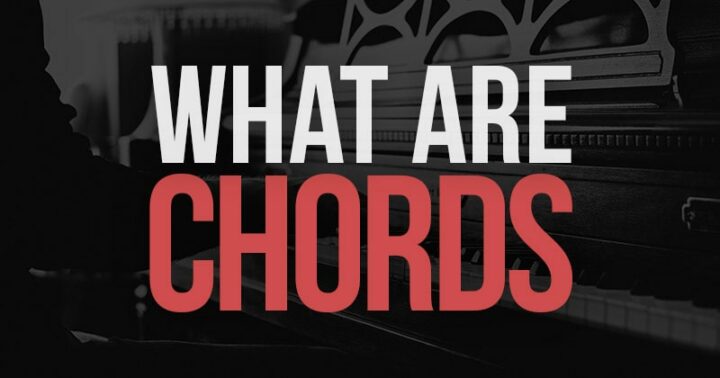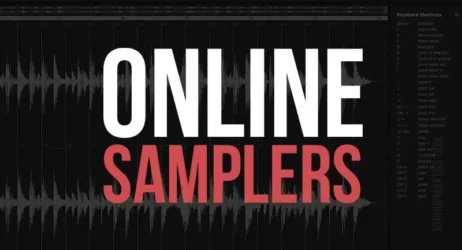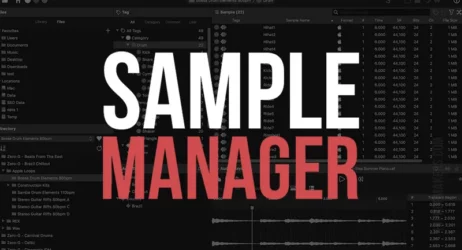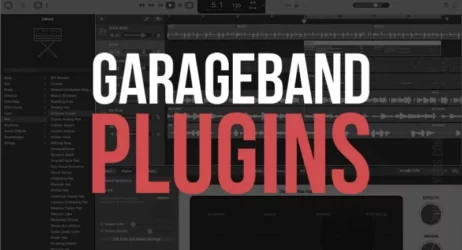This beginner’s guide will answer what is a chord in music, explain the different types of chords, and provide examples of basic chords.
- What is a Chord in Music
- What Defines a Chord
- Types of Chords in Music
- Examples of Chords in Music
- What is a Chord Chart
- How Many Chords Are There
- What Are Chord Progressions
- How Can I Learn Chords
- Should I Learn Chords
- Chords in Music Overview
What is a Chord in Music?
A chord is a music term that refers to a group of notes played at the same time on a musical instrument. A chord forms a harmonic collection of pitches and frequencies to create a harmonious sound. Chords are made up of two or more musical notes.
Chords are generated by superimpositions of third intervals in conventional Western harmony. The fundamental triad is formed by superimposing two conjunct thirds spanning the fifth interval.
For example, the triad c–e–g is formed by superimposing e–g (a minor third) over c–e (a major third).
Seventh chords are formed by superimposing an extra third, such as c–e–g–b or c–e–g–b (c–b, and c–b are major and minor sevenths, respectively).

A third extends the seventh to the ninth (c–e–g–b–d?). In late-nineteenth-century Western art music, seventh and ninth chords, which served as expressive enhancements of fundamental harmonic functions, often supplanted the triad.
More recently, in music that disregarded the conventional harmonic approach in favor of solely melodic-rhythmic dynamics, “tone clusters” of neighboring pitches (for example, c–d–e–f) were used.
Broken chords are the chords that have been melodically broken up into their intervallic modules.
They had long provided basic motivic supplies for instrumental compositions, particularly those of the homophonic variation written in the diatonic harmonic system that administered the late 18th and early 19th centuries when triadic music themes were popular.
Chords are crucial for constructing a song’s structure and defining distinct song portions via chord progressions.
A chord progression is a set of chords that are performed in order. Progressions are utilized to give a song more harmonic substance.
They’re also employed in music to give it a feeling of ‘movement.’ They may also be utilized to provide a melody context and enable the melody’s features to be heard clearly.
A melody is a musical note sequence that is heard as a distinct entity. Chords may also be employed rhythmically to provide interest and variety to a song.
This is especially true in genres like reggae, where rhythm is one of the genre’s distinguishing characteristics.
What Defines a Chord?
A chord is defined as a set of two or more notes performed at the same time. These tones will frequently complement one another, resulting in harmony.
After then, a melody will be performed on top of the harmony.
Chords start with a root note (also known as the starting note). The root note is the lowest-pitched note that serves as the foundation for a chord, and the sort of chord that is being played determines the remainder of the notes.
The chord quality is another name for this.
To develop and apply various characteristics, you must first understand music intervals and how they relate to chord construction and progression.
You can use your music theory knowledge to make chords if you understand the principles of intervals.
Any song or harmony contains intervals.
Intervals, like chords, have their characteristics. An interval might be major, minor, perfect, augmented, or decreased in quality.
To understand how to tie intervals to chords and construct them, you must first understand a scale.
What Are the Different Types of Chords in Music?
Let’s have a look at some different musical chords.
Chords With Two Notes
Intervals are two-note “chords” that are referred to as “chords.” An interval is a difference between 2 pitches in music theory. The quantity and quality of an interval are used to name it.
Dissonant Chords
Diminished and augmented chords are two types of chords with various sound properties and may or may not sound in perfect harmony. They may come off as strange or imbalanced. These chords are “dissonant,” and they may be highly intriguing when carefully placed in music.
Chords With More Than Three Notes
Tetrads, also known as tertian chords, are chords that include more than three notes. These are examples of seventh and additional tone chords, extended chords, changed tone chords, and tone clusters.
Broken Chords
As the name implies, the notes of a broken chord are not performed in unison; rather, they have broken apart into a series of notes. A broken chord may also repeat portions of the chord’s tones.
Progression Chords
A chord progression, often known as a harmonic progression, is an organized set of chords. Harmony in American music and the classical heritage is built on chord progressions.
What Are Examples of Chords in Music?
Many chords are made up of a series of notes separated by small intervals. Chords may be divided into many groups according to their size:
- Tertian chords may be broken down into thirds (major or minor). The C major triad (C–E–G), for example, is characterized by a series of two intervals, the first of which is a major third (C–E) and the second of which is a minor third (E–G). Tertian chords are the most prevalent.
- A succession of (major or minor) seconds may be used to break down secundal chords. The chord C–D–E, for example, is a sequence of seconds that includes a major second (C–D) and a minor second (D–E).
- A sequence of (perfect or augmented) fourths may be used to break down quartal chords. In most cases, perfect and augmented fourths are used in quartal harmony. Diminished fourths are rare because they are enharmonically identical to major thirds. The chord C–F–B, for example, is made up of four fourths, with a perfect fourth (C–F) and an augmented fourth/tritone (F–B).
What is a Chord Chart?
A chord chart is a kind of musical notation that represents the song’s or tune’s main harmonic and rhythmic information. It’s the most frequently used notation by expert session musicians who perform jazz or popular music.
It’s mainly designed for a rhythm segment (usually consisting of guitar, drums, piano, and bass). The players in these categories must improvise the individual chord notes (the “voicing”) and the proper ornamentation, counter melody, or bassline.
Harmony is shown as a sequence of chord symbols atop a typical musical staff in certain chord charts. The rhythmic information may be quite detailed and recorded using a conventional notation known as rhythmic notation.
By replacing numbers for chord names in Nashville notation, the key is left undetermined on the chart.
This makes it easier to alter the key of a song on the fly. Chord charts may also feature explicit sections written in contemporary music notation (such as a melodic riff that provides character to the song), lyrics or lyric fragments, and other information to assist the performer in composing and playing their part.
How Many Chords Are There?
There are two kinds of chords:
- Major chords (C, F, G)
- Minor chords (D, A, E)
Major Chord
A major chord is constructed from the major scale’s first degree. The word degree (sometimes called scale degree) refers to a note’s location on a scale concerning the tonic. The tonic is the scale’s initial degree (or note).
C major chord, F major, and G major are the three keys.
- C major: C, E, and G are the notes that makeup C major.
- F major: F, A, and C are the notes that makeup F Major.
- G major: G major is comprised of the notes G, B, and D.
Minor Chords
A minor chord is constructed from the minor scale’s first degree. Minor chords may also be created by reducing the pitch of a major triad major-third interval by one semitone.
Three separate minor chords make up the harmony of the major scale in the key of C major. D minor, E minor, and A minor are the three keys.
- D Minor: D minor is composed of the notes D, F, and A.
- A Minor: A, C, and E are the notes that make up A minor.
- E minor: The notes E, G, and B make the minor scale in E minor.
What Are Chord Progressions?
A chord progression is a sequence in which chords are performed in a song or piece of music, one after the other. The harmony of a song is made up of the chords you employ and the sequence in which you play them.
Chords and their progressions follow a pattern, much like the rest of the music. The sequence of chords in songs you play or create is known as a chord progression.
Songwriters aim to combine chords that sound well together to help write music. They want chords that make them feel good, sad, angry, tense, gloomy, sexual, or whatever you want to call it!
The chords you use and how they’re put together are crucial as songwriters, and they may aid in the composition of the melody or provide context for how the tune makes us feel.
You may use as many or as few chords as you choose, but a progression must include at least two. A song, on the other hand, may operate with only one chord.
How Can I Learn Chords?
When learning to play acoustic rhythm guitar, the fact is that you should start with tunes that only contain three or four open chords.
This will guarantee that you can learn the song in its entirety and perform it fluently.
Any chord in which the open strings are played is known as an open chord. If you’re a total novice, open chords are a good place to start since they don’t need a lot of finger strength or skill to play.
Your progress with these chords will help you stay motivated to learn more. You can start with the A, E, and D major chords. You’ll be able to play hundreds of songs because they’ll teach you how to play the most basic chord progression in Western music.
Should I Learn Chords?
There are several routes one might pursue to begin learning to play the guitar. Books, YouTube, online guitar schools, conventional courses, and periodicals all have a lot to offer in terms of resources and reference material.
Chord charts and tablature are two of the most common reference aids for learning guitar. A learner needs to learn how to read music to study guitar efficiently.
Traditional sight-reading on the guitar is substantially more difficult than other instruments because multiple distinct pitches are replicated over the fretboard. So, you are recommended to learn chords!
Chords in Music Overview
In wrapping up our exploration of chords in music theory, let’s begin with the basic chords. A chord, like the C major chord or C chord, is created when three notes are played together. Starting from the root note, or starting note, we build these three-note chords.
If the root note is C in the C major chord, the major third (E) and the perfect fifth (G) will follow in the C major triad.
Understanding the major scale is essential to this, with the key of C major being a popular choice to illustrate. Major triads, such as the C major triad and minor triads, create our major and minor chords.
Major chords have a distinct, bright sound like the vibrant tones often heard in pop music. In contrast, minor chords, which contain a minor third, give a somewhat sad or introspective feel, which is more common in rock music.
The major chord isn’t the only type of chord, though. Seventh chords, like the dominant seventh chord, add an extra note to the triad chord. The major key can also have a major, minor, or diminished seventh chord.
The fully diminished chord, such as the C diminished chord or the diminished seventh chord, has a tense, dissonant sound due to the diminished fifth, also known as the tritone.
Extended chords, including the ninth, eleventh, and thirteenth chords, build even further on this foundation, extending the chord quality beyond the basic triad.
Altered chords and added tone chords introduce extra, non-scale notes or alter some of the notes in the chord to produce a unique sound.
A chord symbol represents each chord, showing the root note and the chord quality. Chord qualities include major, minor, augmented, and diminished chords, like the major chord or the minor chord.
The major chord, formed by a major triad, creates a cheerful sound, while the minor chord, built from a minor triad, has a sadder tone.
Augmented chords, containing an augmented fifth, and diminished chords, with a diminished triad and a diminished fifth, provide even more variety.
An augmented chord might sound strange or tense because it raises the fifth note, whereas a diminished chord, which lowers the fifth note, might sound unstable or unresolved.
Chords can also be played in different arrangements or inversions. An inverted chord has a note other than the root note at the bottom. Even the same three notes can sound quite different depending on the root position.
This diverse world of chords, from the two or more chords played together to the stunning variety of chord types, gives music its rich, expressive power.
Whether in the hands of a classical composer or a modern rock musician, chords are the building blocks of music that evoke our deepest emotions.
So, the next time you listen to your favorite song, try to listen for the chords and see if you can identify any!
I hope you now understand chords, and we answered what is a chord in music.




